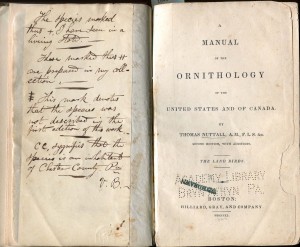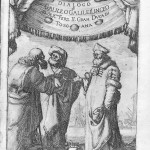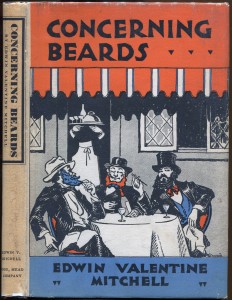 Just acquired, a copy of Nuttall’s Manual of the Ornithology of the United States and Canada (Boston, 1840) which belonged to Vincent Barnard, a 19thC Pennsylvania naturalist.
Just acquired, a copy of Nuttall’s Manual of the Ornithology of the United States and Canada (Boston, 1840) which belonged to Vincent Barnard, a 19thC Pennsylvania naturalist.
The author of the book, Thomas Nuttall (1786-1859), was born in Yorkshire, worked as an apprentice printer in Liverpool, and became so enamored of natural history that he emigrated to Philadelphia in 1808, where he found a mentor and patron in professor Benjamin S. Barton (U Penn). Nuttall then traveled the U.S., from the Great Lakes to New Orleans, and across the southeast. Returning to the Northeast, he lectured at Yale in 1822 (on botany) and was appointed curator of the Botanic Garden at Harvard in 1823, lecturing there until 1834. His study of birds dates from this period, from which the present book was produced.
A former owner of this book was Vincent Barnard (1825-1871), a native of Pennsylvania described as “naturalist, botanist, ornithologist, entomologist, taxidermist, mineralogist, artisan and universal genius.” On one of the blank fly-leaves is written “Vincent Barnard Bought Philada 8th Mo 2nd, 1847,” and a two-page “list of new species described by Audubon discovered since the publication of Nuttall’s manual.” Shown here, opposite the title-page, is an explanation of Barnard’s annotating system:
“The species marked thus + , I have seen in a living state”
“Those marked thus ++ are prepared in my collection.”
“[three vertical plus signs] This mark denotes that the species was not described in the first edition of this work”
“cc signifies that the species is an inhabitant of Chester County, PA.”
 Last night we were happy to host Michelangelo Zaccarello (Università di Verona), a philologist and expert on book history, who held a two-hour “master class” seminar on several early printed books from Italy in the Watkinson’s collection.
Last night we were happy to host Michelangelo Zaccarello (Università di Verona), a philologist and expert on book history, who held a two-hour “master class” seminar on several early printed books from Italy in the Watkinson’s collection. and why he chose these in particular. He also emphasized the book market in Italy in the Renaissance and Early Modern period, and spoke with knowledge about the market conditions for these rarities today.
and why he chose these in particular. He also emphasized the book market in Italy in the Renaissance and Early Modern period, and spoke with knowledge about the market conditions for these rarities today.


